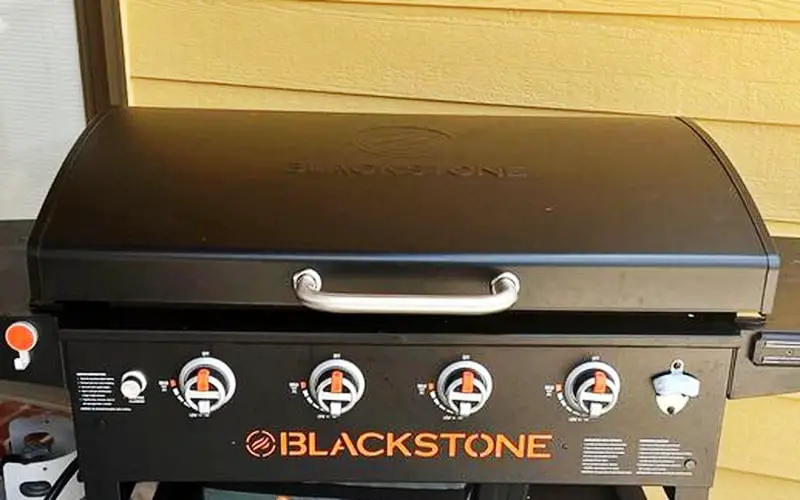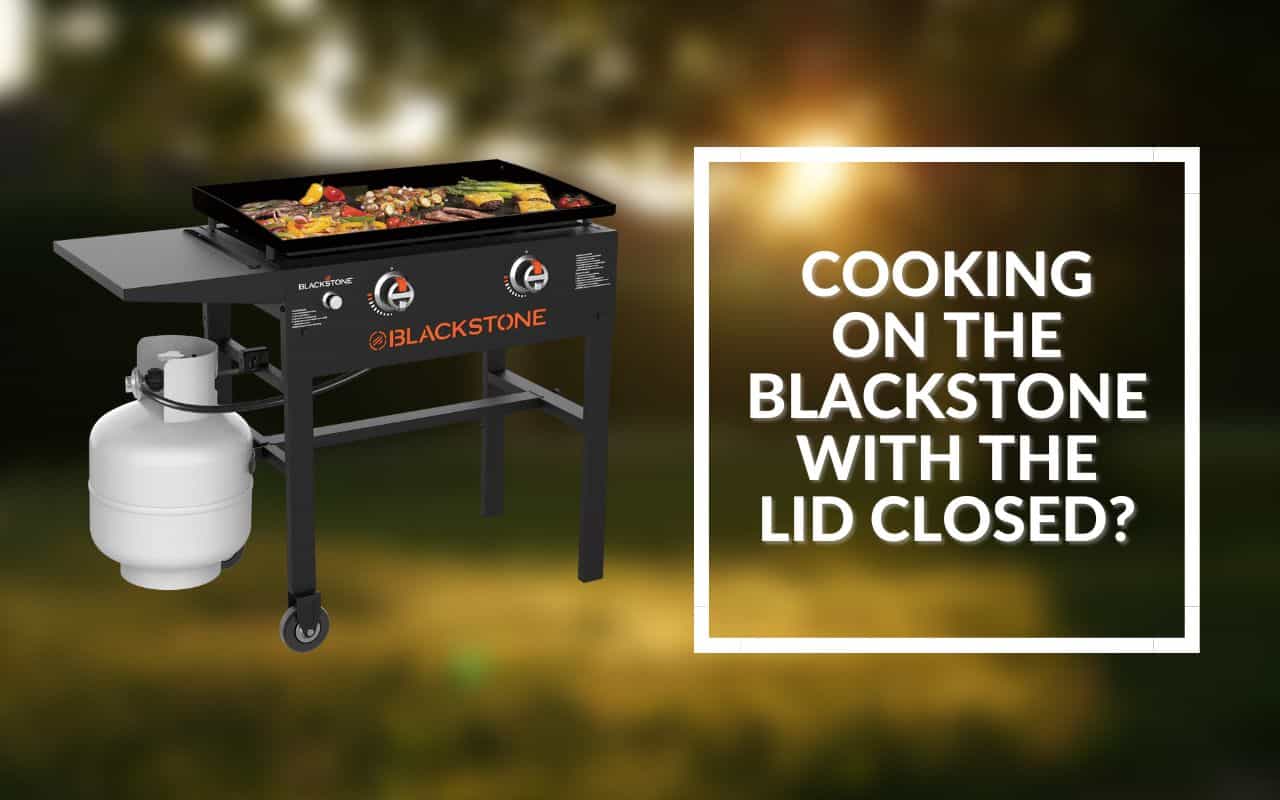Today, we’ll be diving headfirst into the great lid debate: to close or not to close. Specifically, we’ll be looking at the Blackstone griddle and if we can indeed cook with the lid closed.
The griddles come in various models, some with lids, and some without, adding to the complexity of the lid debate. It’s enough to make your head spin faster than a rotisserie chicken, right? But don’t worry, I’ve got the scoop for you.
Here’s the quick and dirty:
If you have a Blackstone model that comes with a hinged hood, you can close the lid down when cooking. On the flip side, models that come with simple flat covers aren’t meant to be cooked on with the cover in place.
Okay, quick answer out of the way, but if you’re anything like me, you probably have more questions, right? Well, stick around. We’re about to dig deeper into this lid business, so sit tight and read on!
Table of Contents
- Can You Really Cook on Blackstone with the Lid Closed?
- Pros and Cons of Grilling with a Lid
- Consider Using a Basting Dome Instead of a Hood
- Wrapping Up
- FAQ
Can You Really Cook on Blackstone with the Lid Closed?
Let’s break it down further. You’re probably asking, “Can I really cook on my Blackstone with the lid closed?” The answer, in short, is yes, as we’ve already covered in the previous section, but there’s more to it.
It’s essential to understand that there are different types of lids when it comes to Blackstone griddles.
Some Blackstone griddles come with a hinged hood, others with a flat cover, and some without any cover at all.

Regardless of how your griddle arrived, some models can always be upgraded with a hinged hood that Blackstone sells separately. So, if you ever come across a website or a grill guru saying that you can only cook with the lid closed if your griddle came with one, toss that piece of advice onto the barbecue and let it sizzle away.
Remember, when in doubt, there’s no harm in checking the user manual or reaching out to Blackstone’s customer service. They’re the folks who’ve engineered these grilling beauties, so they know a thing or two about how to use them!
Now let’s explore the two types of lids a bit more:
- Hoods: These guys are designed to be used during cooking. They’re taller and create a mini oven-like environment where the heat surrounds your food for an even and efficient cook. Think of them as the penthouse suite for your sizzling steaks.
- Covers: On the other hand, flat covers aren’t designed for cooking. They’re more like the bouncer at the club – they protect the griddle top when it’s not in use. These covers are shallow and don’t have room to accommodate cooking. Slap one of these on while you’re cooking, and you could risk damaging it with warping or other heat-related issues.

Another thing to consider is that there are also third-party lids available for purchase. However, you will have to do your own homework to see whether a specific cover can or cannot be used while cooking.
Pros and Cons of Grilling with a Lid
Fantastic, let’s march on to the ‘Pros and Cons of Cooking with the Lid Closed’. I’ve heard from both camps – the lid-lovers and the lid-leavers – and let me tell you, they both have their points. Let’s delve into them:
Pros of a Closed Lid
- Maintains a constant temperature: Just like a cozy winter blanket, a closed lid keeps all the heat nice and snug around your food. It helps maintain a constant temperature on the griddle, which is like the secret sauce for cooking food evenly.
- Helps with even cooking: Speaking of even cooking, a closed lid helps distribute the heat more uniformly across the cooking surface. Think of it as a hot hug for your food from all sides!
- Prevents food from drying out: Cooking with the lid closed traps the moisture from the food inside, keeping it juicy and tender. It’s a spa day for your food, locking in all that natural moisture.
- Prevents splatters: Ah, splatters, the nemesis of a clean grill (and clean grilling clothes!). Cooking with the lid closed keeps those rebellious droplets in check.
- Reduces cooking time: Trapped heat doesn’t just cook food more evenly; it also cooks it faster. So, if you’re in a hurry to get the food on the plate, the lid is your best friend.
Cons of a Closed Lid
Now that we’ve covered the sunny side, let’s take a peek at the shadows:
- Limited visibility: With the lid closed, keeping an eye on your food becomes a bit tricky. You have to lift the lid to check, and each time you do that, you’re letting some of that heat escape.
- Potential for steam buildup: Remember how we talked about the lid trapping moisture? Well, sometimes there can be too much of a good thing. With the hood down, steam can build up inside, which might turn your crispy grilled veggies into something more akin to steamed broccoli. Not to mention the spectacular white cloud that escapes once you lift the hood.
- Cleanup: If you close the lid, you will most likely have to clean after the griddling session and it’s not as easy as cleaning the griddle top.
So, there you have it – the good, the bad, and the steamy of cooking with the lid closed. As with everything in life, it’s about understanding your tools and using them to their best advantage.
Consider Using a Basting Dome Instead of a Hood
Think of the basting dome as that superhero sidekick. It’s like Robin to your Batman, or Chewbacca to your Han Solo. These fantastic little tools can provide the same advantages as a lid but on a smaller, more specific scale.
Let’s say you’re grilling a medley of goodies. Some sizzling burgers on one side, some veggies on the other, and maybe a couple of hot dogs thrown in for good measure. But then, you want to melt some cheese onto those burgers without turning your veggies into a steamy mess. Enter the basting dome. Just place it over the burgers, and voila! You’ve got yourself a mini lid working its magic on those burgers while the rest of the food cooks as intended.
Basting domes are pretty budget-friendly and come in various shapes and sizes to accommodate different needs. So, whether you’re cooking a giant pizza or just a humble cheeseburger, there’s a basting dome out there with your name on it. Heck, they can even be used for smoking meat on the griddle! Who needs a smoker when you’ve got a griddle?
Wrapping Up
As we close this fiery debate, I’d say it’s clear as a summer day: Yes, you can cook on your Blackstone griddle with the lid closed, but make sure it’s the right kind of lid. If you’re using a model with a hinged hood, you’re all set to grill with it closed. However, if you’ve got the shallow flat cover, better keep it off the griddle while the heat is on.
The lid, whether it’s a hood or a basting dome, is like an extra tool in your grilling arsenal. And like any tool, it works best when used correctly. Weigh the pros and cons, consider the food you’re cooking, and use your best judgment.
FAQ
Can I add a hinged hood to my Blackstone griddle if it didn't come with one?
Blackstone sells hoods separately, so you can always upgrade your flat-top grill with a hood if it’s one of the supported models.
Do I always need to cook with the lid closed on my Blackstone griddle?
Not at all. The lid – or lack thereof – is just one factor in your grilling journey. Depending on what you’re cooking, and how you like it cooked, you might want to use the lid or leave it open.
Does a basting dome work the same way as a lid?
Yes and no. A basting dome provides many of the same benefits as a lid, but it does so on a smaller scale. It’s ideal for when you want to create a closed cooking environment for just a portion of your griddle.
What should I do if I'm still unsure about using the lid on my Blackstone griddle?
When in doubt, don’t hesitate to check the user manual or reach out to Blackstone’s customer service. They’re always ready to help grillers like us make the most out of our cooking experiences.
Can you cook on the electric Blackstone with the lid closed?
Absolutely, you can cook on the griddle with the lid closed. What’s great about the 22-inch electric Blackstone is that the top of the lid is made of glass. This allows you to see what’s going on on the griddle without having to raise the lid.

